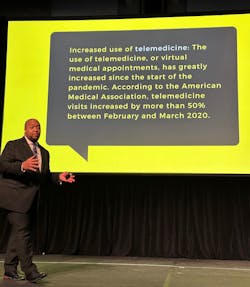In the minds of many, the metaverse remains an abstract and idealistic concept. Yet, the convergence of technologies is enabling the next level of interaction in the virtual and physical worlds and providing strategic business opportunities.
By 2026, 25% of people will spend at least one hour a day in a metaverse for work, shopping, education, social media and/or entertainment, estimate Gartner analysts. They also expect the industrial metaverse to thrive as a result of maturing immersive technologies.
For the sake of simplicity, think of the metaverse as a supercharged internet, where multiple technologies converge to enable virtual interaction and digital economy. Within this ecosystem, one finds artificial intelligence, machine learning, deep learning, neural networks and digital twins, as well as extended reality (a catchall for augmented reality, virtual reality and mixed reality), robotics and automation. Add FinTech (including crypto assets such as DeFi and dApps) to the mix, and a collective virtual space emerges.
None of these technologies are new. It’s what happens when these technologies become interoperable in a unified virtual ecosystem that one can appreciate the formation and potential of a metaverse, said Gatherverse founder Christopher Lafayette, whose keynote at MD&M West 2023 in Anaheim (Feb. 7-9) centered on how immersive medical technology is developing through the metaverse.
Such ecosystems are “growing and scaling at a rapid clip, unlike anything we’ve ever seen before,” Lafayette said. What’s mystifying, he noted, is that no-one—not even your best so-called futurist—knows what this will turn into.
READ MORE: Finger to the Wind: MD&M West 2023 Exhibitors Call the Trends
Industrial IoT Leads the Charge
Once designed for highly niche applications, IIoT technologies such as digital twins, AI and edge computing have tipped the scales, evolving to become game-changing enablers for testing and monitoring in industrial applications. So much so, that ABI Research views the industrial segment—where operational results, automation and monetization potential shows early traction—to be the “surer bet” relative to consumer or enterprise segments.
Investments in digital transformation are skyrocketing, with revenues for industrial digital twin and simulation and industrial extended reality expected to hit $22.73 billion by 2025 as organizations use Industry 4.0 tools.
Game-Changing Enablers
Since the pandemic, the world has observed a leap in disruptive technology that would not have been possible without cloud enablement. “I subscribe to you that if the pandemic happened just seven years ago, we would have grossly failed without the power of the global cloud…We have become more virtual in the past 36 months than we had the past 36 years,” Lafayette argued.
One of the effects of becoming virtual is that people realize that there’s more that they can do beyond sending files to one another and exchanging information. “We can buy, sell and trade within these virtual ecosystems,” he said. “We’ve never been more virtual than we are in this new hybrid world, and we’re not going back.”
Knock-on Effects
Lafayette, an emergent technologist and humanitarian in virtual and augmented reality, warned that manufacturers should expect to see the establishment of public and private sector government laws, rules, foundations and ethics as business models mature alongside technologies. Gatherverse, which launched in 2021, has a specific focus on humanity-first standards of accessibility, education, equality, community development, safety, privacy and wellness, and ethics. The platform was established to bring together multi-disciplinary professionals to consider stakeholder impacts.
Concerns about having ethical standards and guardrails are especially relevant for the MedTech sector—a rapidly advancing industry worth $521.9 billion by 2026 at a CAGR of 6.1%, according to Lafayette. To this end, he underscored the impact of disruptive technologies in the hospital ecosystem: There are more than 5,534 hospitals in the United States, with 7.9 million beds, an average of 200 to 300 rooms per hospital, and a minimum of 200 to 1,000 employees at each.
“There are up to 1,000 vendors that contribute ceiling to floor, floor to ceiling, wall to wall and everything in between,” not including the teams it took to build the hospitals, he said.
Advancing Telemedicine
The knock-on effects were never clearer than when the pandemic was declared in March 2020. That’s when the general public was coopted into “a giant case study and everyone had to participate,” Lafayette reminded the audience. Since then, hospitals have recognized how much more sensible it could be to operate with distributed and remote workforces. From a practical standpoint, telemedicine has become convenient for both the practitioner and patient.
The MedTech industry is actively turning to artificial intelligence and the study of deep medicine for ways to operate virtually, in hyper-realistic, immersive and simulated environments. The industry is looking at ways to interweave technologies that will enable doctors to treat more patients and to improve “deal flow and dollars” that deliver healthcare more efficiently and remotely, Lafayette explained. These enablers drive interest in remote diagnostic technologies, monitoring devices and wearables.
Prepare for Obsolescence
In addition, the disruptive nature of emergent technologies—such as Meta and ChatGPT—have carved a path for a litany of other artificial intelligence platforms coming online. This development will affect career paths and companies, from those at the C-suite level and management to those who have to make decisions on product development.
“My consideration for you is to be diligent and to get ready to understand that your world is getting ready to change,” Lafayette advised. “I do encourage every platform to make sure that they hire someone that understands the emerging nature of these technologies.”
READ MORE: Product Teasers for a Productive Booth Crawl at IME West 2023
But while advanced technologies mean definitive changes for the industry, Lafayette advised manufacturers to be cautious with budgets, as the tools available to create a digital twin today will likely be outdated within the next 12 to 24 months.
Instead, he said, manufacturers would be wise to have “an appreciation for the cadence and how we develop and design within platforms, especially when it comes to building for MedTech development.”
What is the Metaverse Good for Today?
For Lafayette, the metaverse is good for showcasing product and for surgical theater training and testing, including digital cadaver development. “Surgeons can afford to make mistakes within digital training construct environments,” he said. “What we don’t want to happen is for them to make mistakes in the real theater.”
The metaverse also shows promise for telepresence. As an example, Lafayette described a scenario where a specialist who operates from Costa Rica may be one of the only practitioners in the world who can perform a particular operation. If Lucile Packard Children’s Hospital Stanford needed her expertise, but a flight would be too long for what was needed in an emergency situation, the doctor would be able to teleport and translate her capability through the metaverse, he said.
In other words, the doctor could be teleported into the operating room, control a DaVinci machine and perform precision, gestural interface operations on the patient through point cloud, including where to make the incisions and cuts. “That is something that is capable today and will happen more abundantly,” said Lafayette.
About the Author

Rehana Begg
Editor-in-Chief, Machine Design
As Machine Design’s content lead, Rehana Begg is tasked with elevating the voice of the design and multi-disciplinary engineer in the face of digital transformation and engineering innovation. Begg has more than 24 years of editorial experience and has spent the past decade in the trenches of industrial manufacturing, focusing on new technologies, manufacturing innovation and business. Her B2B career has taken her from corporate boardrooms to plant floors and underground mining stopes, covering everything from automation & IIoT, robotics, mechanical design and additive manufacturing to plant operations, maintenance, reliability and continuous improvement. Begg holds an MBA, a Master of Journalism degree, and a BA (Hons.) in Political Science. She is committed to lifelong learning and feeds her passion for innovation in publishing, transparent science and clear communication by attending relevant conferences and seminars/workshops.
Follow Rehana Begg via the following social media handles:
X: @rehanabegg
LinkedIn: @rehanabegg and @MachineDesign


